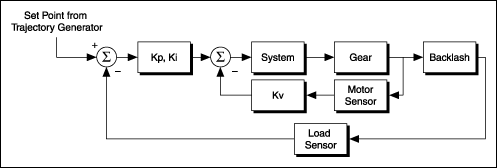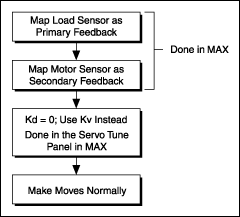Dual Loop Feedback
Motion control systems often use gears to increase output torque, increase resolution, or convert rotary motion to linear motion. The main disadvantage of using gears is the backlash created between the motor and the load. This backlash can cause a loss of position accuracy and system instability.
The control loop on the motion system corrects for errors and maintains tight control over the trajectory. The control loop consists of three main parts—proportional, integral and derivative—known as PID parameters. The derivative part estimates motor velocity by differentiating the following error (position error) signal. This velocity signal adds, to the loop, damping and stability. If backlash is present between the motor and the position sensor, the positions of the motor and the sensor are no longer the same. This difference causes the derived velocity to become ineffective for loop damping purposes, which creates inaccuracy in position and system instability.
Using two position sensors for an axis can help solve the problems caused by backlash. As shown in the following figure, one position sensor resides on the load and the other on the motor before the gears. The motor sensor is used to generate the required damping and the load sensor for position feedback. The mix of these two signals provides the correct position feedback with damping and stability.

 |
Tip You can enable dual-loop feedback on the NI motion controller by mapping an encoder as the secondary feedback for the axis, and then using the velocity feedback gain instead of the derivative gain to dampen and stabilize the system, as shown in the following figure. |
